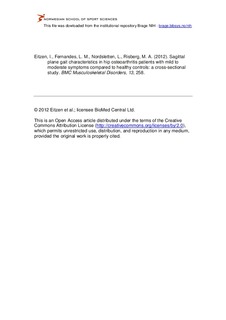| dc.contributor.author | Eitzen, Ingrid | |
| dc.contributor.author | Fernandes, Linda | |
| dc.contributor.author | Nordsletten, Lars | |
| dc.contributor.author | Risberg, May Arna | |
| dc.date.accessioned | 2013-04-11T07:41:55Z | |
| dc.date.available | 2013-04-11T07:41:55Z | |
| dc.date.issued | 2012-12-20 | |
| dc.identifier | Seksjon for idrettsmedisinske fag / Department of Sports Medicine | |
| dc.identifier.citation | BMC Musculoskeletal Disorders. 2012, 13, 258 | no_NO |
| dc.identifier.uri | http://hdl.handle.net/11250/170934 | |
| dc.description | © 2012 Eitzen et al.; licensee BioMed Central Ltd.
This is an Open Access article distributed under the terms of the Creative Commons Attribution License (http://creativecommons.org/licenses/by/2.0), which permits unrestricted use, distribution, and reproduction in any medium, provided the original work is properly cited. | no_NO |
| dc.description.abstract | Background
Existent biomechanical studies on hip osteoarthritic gait have primarily focused on the end stage of disease. Consequently, there is no clear consensus on which specific gait parameters are of most relevance for hip osteoarthritis patients with mild to moderate symptoms. The purpose of this study was to explore sagittal plane gait characteristics during the stance phase of gait in hip osteoarthritis patients not eligible for hip replacement surgery. First, compared to healthy controls, and second, when categorized into two subgroups of radiographic severity defined from a minimal joint space of ≤/>2 mm.
Methods
Sagittal plane kinematics and kinetics of the hip, knee and ankle joint were calculated for total joint excursion throughout the stance phase, as well as from the specific events initial contact, midstance, peak hip extension and toe-off following 3D gait analysis. In addition, the Western Ontario and McMaster Universities Osteoarthritis Index, passive hip range of motion, and isokinetic muscle strength of hip and knee flexion and extension were included as secondary outcomes. Data were checked for normality and differences evaluated with the independent Student’s t-test, Welch’s t-test and the independent Mann–Whitney U-test. A binary logistic regression model was used in order to control for velocity in key variables.
Results
Fourty-eight hip osteoarthritis patients and 22 controls were included in the final material. The patients walked significantly slower than the controls (p=0.002), revealed significantly reduced joint excursions of the hip (p<0.001) and knee (p=0.011), and a reduced hip flexion moment at midstance and peak hip extension (p<0.001). Differences were primarily manifested during the latter 50% of stance, and were persistent when controlling for velocity. Subgroup analyses of patients with minimal joint space ≤/>2 mm suggested that the observed deviations were more pronounced in patients with greater radiographic severity. The biomechanical differences were, however, not reflected in self-reported symptoms or function.
Conclusions
Reduced gait velocity, reduced sagittal plane joint excursion, and a reduced hip flexion moment in the late stance phase of gait were found to be evident already in hip osteoarthritis patients with mild to moderate symptoms, not eligible for total hip replacement. Consequently, these variables should be considered as key features in studies regarding hip osteoarthritic gait at all stages of disease. Subgroup analyses of patients with different levels of radiographic OA further generated the hypothesis that the observed characteristics were more pronounced in patients with a minimal joint space ≤2 mm. | no_NO |
| dc.language.iso | eng | no_NO |
| dc.publisher | BioMed Central | no_NO |
| dc.subject | osteoarthritis | no_NO |
| dc.subject | hip | no_NO |
| dc.subject | biomechanics | no_NO |
| dc.subject | gait analysis | no_NO |
| dc.title | Sagittal plane gait characteristics in hip osteoarthritis patients with mild to moderate symptoms compared to healthy controls: a cross-sectional study | no_NO |
| dc.type | Journal article | no_NO |
| dc.type | Peer reviewed | no_NO |
| dc.subject.nsi | VDP::Medical disciplines: 700::Basic medical, dental and veterinary science disciplines: 710 | no_NO |
| dc.subject.nsi | VDP::Medical disciplines: 700::Health sciences: 800 | no_NO |
| dc.identifier.doi | 10.1186/1471-2474-13-258 | |
